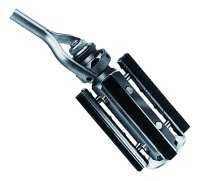
|
|
A typical straight cylinder hone. A great tool when used right, which unfortunately, it often is not. It is never correctly used once the engine has been assembled. Its correct use is only as the final step in cylinder boring.
|
Whether because of ignorance or laziness or a misunderstanding of modern Japanese engine technology, there are many in books and on the Internet promoting a Japanese motorcycle engine assembly ethic that is completely wrong.
If properly assembled, with a straight and round bore, correct piston to cylinder clearance, the correct fitment and type of rings, honed correctly, and with a proper valve job, the newly-assembled engine will have the most compression it will ever have. Compression will not increase with miles and time. The idea that it will is a myth. There will be no "breaking-in." It is only when an engine is assembled incorrectly that breaking-in takes place in cylinders or valves. All one has to do is look at the kinds of clearances Japanese powersports manufacturers use for the fitment of their cylinders to see the truth of this. Which is why I have published them.
And this brings us to honing. User forums further the assembly fallacy with their frequent recommendation of using a hone when simply fitting new rings, and their fairly consistent promotion of removing rust or oxidation in cylinders by, again, the use of a hone. Cylinder hones, whether portable or floor mounted, are intended as the final step in the process of boring a cylinder. They have no other legitimate use. Such an operation is never to be done to fit rings, and is never the correct solution to repairing cylinder rust, precisely because metal is removed, thereby upsetting the careful proper piston to cylinder clearance the factory calls for.
|

 ®
®
